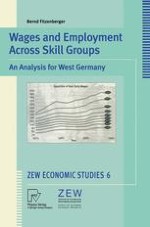1999 | OriginalPaper | Buchkapitel
Basic Trends in Wages and Employment Across Skill Groups
verfasst von : Prof. Bernd Fitzenberger, Ph. D.
Erschienen in: Wages and Employment Across Skill Groups
Verlag: Physica-Verlag HD
Enthalten in: Professional Book Archive
Aktivieren Sie unsere intelligente Suche, um passende Fachinhalte oder Patente zu finden.
Wählen Sie Textabschnitte aus um mit Künstlicher Intelligenz passenden Patente zu finden. powered by
Markieren Sie Textabschnitte, um KI-gestützt weitere passende Inhalte zu finden. powered by
The stylized view of the labor market in West Germany during the 70’s and 80’s considers West Germany to be a high-wage and high-productivity economy with a fairly compressed wage structure and resulting insufficient employment growth. In particular, wage floors set by the prevailing wage bargaining system result in a lack of jobs for low-skilled workers (refer to the two-sides-of-the-same-coin hypothesis discussed in chapter 1). This view is“confirmed” by descriptive evidence showing that the distribution of wages has been stable or even“continued to become more compressed” in situations of considerable unemployment and imbalances in the distribution of unemployment across different groups of workers (see Abraham and Houseman, 1995, Kraft, 1994, Paqué, 1995, Pischke, 1998, Steiner and Wagner, 1998, OECD, 1993, 1996, or Fitzenberger and Kurz, 1997). This evidence is based either on aggregate data for different groups of workers or on micro datasets such as the German Socioecomic Panel or the Qualifications and Careers Survey (“Qualifikation und Berufsverlauf”, data collected by the Federal Institute for Occupational Training (Bundesinstitut für Berufsbildung, BiBB) and the research institute of the Federal Employment Service (IAB). On the employment side, West Germany exhibited modest employment growth (small compared to the United States) with a continuous trend towards skill upgrading of the labor force (see figure A.1 in the appendix).
